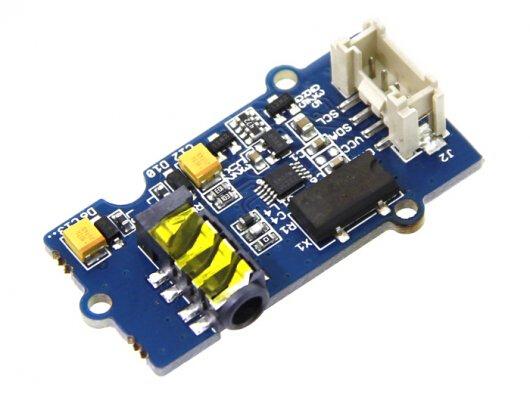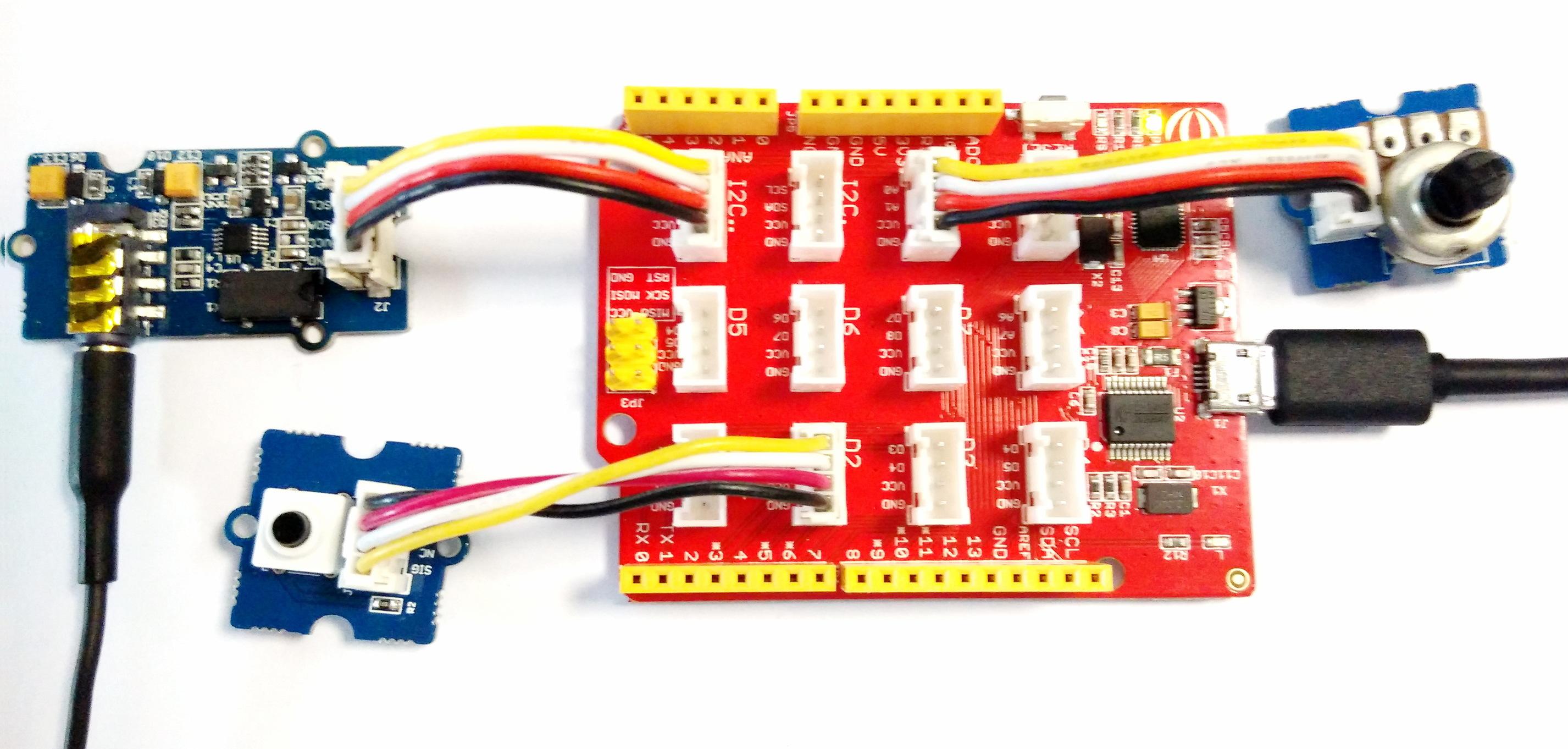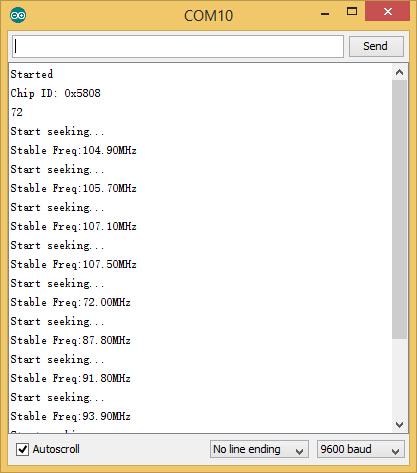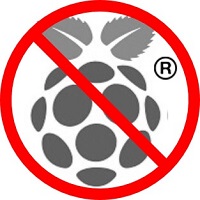Grove - I2C FM Receiver
Introduction

Grove - I2C FM Receiver is a wideband FM receiver module, this module is based on RDA5807M. The RDA5807M series are the latest generation single-chip broadcast FM stereo radio tuner with fully integrated synthesizer. The RDA5807M series have a powerful low-IF digital audio processor. The Grove - I2C FM Receiver has a headset jack, so it can connect to earphones or audio.
Version
| Revision | Description | Release date |
|---|---|---|
| Grove - I2C FM Receiver v1.0 | Initial public release | |
| Grove - I2C FM Receiver v1.1 | Fixed bug - DFM for J3 | Dec 2, 2011 |
Features
- Grove interface
- Supports worldwide frequency band: 50 - 115MHz
- Support RDS/RBDS
- Lower power consumption
- Headset interface
- Digital auto gain control
- Input voltage: 3.3V - 5V
Tip
More details about Grove modules please refer to Grove System
Platforms Supported
Getting Started
Connection
Here we will show you how this Grove - I2C FM Receiver works via a simple demo. First of all, you need to prepare the below stuffs:
| Seeeduino Lotus | Grove - I2C FM Receiver | Grove - Button | Grove - Rotary | Earphone |
|---|---|---|---|---|
 |
 |
 |
 |
 |
| Get ONE Now | Get ONE Now | Get ONE Now | Get ONE Now | NA |

Software
-
Please follow how to install an arduino library procedures to install library.
-
Download Grove-I2C FM Receiver library and then install library.
-
Copy below code to sketch and upload to Lotus.
/*
* I2C_FM.ino
* Demo code for the Grove-I2C_FM_Receiver module
*
* Copyright (c) 2012 seeed technology inc.
* Website : www.seeed.cc
* Author : Jack Shao (jacky.shaoxg@gmail.com)
* Create Time: Jul 2014
* Change Log :
*
* The MIT License (MIT)
*
* Permission is hereby granted, free of charge, to any person obtaining a copy
* of this software and associated documentation files (the "Software"), to deal
* in the Software without restriction, including without limitation the rights
* to use, copy, modify, merge, publish, distribute, sublicense, and/or sell
* copies of the Software, and to permit persons to whom the Software is
* furnished to do so, subject to the following conditions:
*
* The above copyright notice and this permission notice shall be included in
* all copies or substantial portions of the Software.
*
* THE SOFTWARE IS PROVIDED "AS IS", WITHOUT WARRANTY OF ANY KIND, EXPRESS OR
* IMPLIED, INCLUDING BUT NOT LIMITED TO THE WARRANTIES OF MERCHANTABILITY,
* FITNESS FOR A PARTICULAR PURPOSE AND NONINFRINGEMENT. IN NO EVENT SHALL THE
* AUTHORS OR COPYRIGHT HOLDERS BE LIABLE FOR ANY CLAIM, DAMAGES OR OTHER
* LIABILITY, WHETHER IN AN ACTION OF CONTRACT, TORT OR OTHERWISE, ARISING FROM,
* OUT OF OR IN CONNECTION WITH THE SOFTWARE OR THE USE OR OTHER DEALINGS IN
* THE SOFTWARE.
*/
//
/*
* Modifications to the I2C_FM.ino by Mel Patrick - Wabbit Wanch Design
* Modified routines for scanning UP or DOWN through the FM band
* Modified routine to test for signal strength of received station
* Modified routines to support bass boost and MONO signal
* RSSI, read it too soon after setting a station and you get a small value
* so it's better to wait a bit (50ms) and try it. minSignalStrength will
* skip locking on a station with a weak signal (you could set the MONO bit) to get
* better reception on these stations.
*/
#include <Arduino.h>
#include <Wire.h>
#include <EEPROM.h>
#define BTNUP 2// used for seeking UP (normally CLOSED push button)
#define VOL_POT A0// volume POT LOG taper 10K
#define BTNDN 3// used for seeking DOWN (normally CLOSED push button)
uint16_t gChipID = 0;
uint8_t RDA5807P_REGW[10];
#define I2C_ADDR 0x10
#define READ 1
#define WRITE 0
#define ADRW 0x20
#define ADRR 0x21
//
//#define _SHARE_CRYSTAL_24MHz_
//#define _SHARE_CRYSTAL_12MHz_
#define _SHARE_CRYSTAL_32KHz_
//#define _FM_STEP_50K_
//5807M,5807FP,5807NN,5807NP
uint8_t RDA5807N_initialization_reg[]={
#if defined(_SHARE_CRYSTAL_24MHz_)
0xC4, 0x51, //02H:
#elif defined(_SHARE_CRYSTAL_12MHz_)
0xC4, 0x11, //02H:
#elif defined(_SHARE_CRYSTAL_32KHz_)
0xC4, 0x01,//change 01 to 05 enables the RDS/RBDS
#else
0xC0, 0x01,
#endif
0x00, 0x00,
0x04, 0x00,
0xC3, 0xad, //05h
0x60, 0x00,
0x42, 0x12,
0x00, 0x00,
0x00, 0x00,
0x00, 0x00, //0x0ah
0x00, 0x00,
0x00, 0x00,
0x00, 0x00,
0x00, 0x00,
0x00, 0x00,
0x00, 0x00, //0x10h
0x00, 0x19,
0x2a, 0x11,
0xB0, 0x42,
0x2A, 0x11, //
0xb8, 0x31, //0x15h
0xc0, 0x00,
0x2a, 0x91,
0x94, 0x00,
0x00, 0xa8,
0xc4, 0x00, //0x1ah
0xF7, 0xcF,
0x12, 0x14, //0x1ch
0x80, 0x6F,
0x46, 0x08,
0x00, 0x86, //10000110
0x06, 0x61, //0x20H
0x00, 0x00,
0x10, 0x9E,
0x23, 0xC8,
0x04, 0x06,
0x0E, 0x1C, //0x25H //0x04 0x08
};
int16_t freq = 10110;
uint16_t vol = 1;
//
// added items - Mel
boolean bassBit = true;// bass boost
boolean monoBit = false;// force MONO not stereo
const boolean seekUP = true;
const boolean seekDN = false;
uint8_t minSignalStrength = 36;// anything below this probably set a MONO flag for better reception
uint8_t signalStrength;
long previousMillis = 0;// last time the function was called
long interval = 2000;// interval for the signal level function (2 seconds)
int8_t stationStep = 10;// kHz steps bewteen the stations (North America = 10)
boolean hasVolumePot = false;// flag if you have a POT attached or not
//
void setup()
{
Wire.begin();
loadDefaults();// load any defaults from previous radio settings
Serial.begin(9600);
Serial.println("Started");
//=======================
//rda5807 power on
RDA5807P_PowerOnReset();
RDA5807P_SetMute(false);
//=======================
pinMode(BTNUP, INPUT_PULLUP);
pinMode(VOL_POT, INPUT);
pinMode(BTNDN, INPUT_PULLUP);
//=======================
RDA5807P_SetVolumeLevel(vol);// use this if you don't have a POT for volume attached (0-15)
RDA5807P_SetFreq( freq );
}
void loop()
{
unsigned long currentMillis = millis();
if(currentMillis - previousMillis > interval) {
// save the last time you blinked the LED
previousMillis = currentMillis;
showSignalStrength();
}
//
if (digitalRead(BTNUP) == 1)
{
delay(100);
if (digitalRead(BTNUP) == 1)
fmSeek(seekUP);
while(digitalRead(BTNUP) == 1);
}
if (digitalRead(BTNDN) == 1)
{
delay(100);
if (digitalRead(BTNDN) == 1)
fmSeek(seekDN);
while(digitalRead(BTNDN) == 1);
}
if (hasVolumePot == true) setVolume();// use this to read the POT
}
//
void setVolume() {
unsigned int temp_vol;
temp_vol = analogRead( VOL_POT );
if (abs(temp_vol - vol)>5)
{
if (vol != temp_vol) {// don't bother changing the volume if unless the pot moves
vol = temp_vol;
unsigned char hex_vol = map(vol, 0, 1023, 0, 0xf);
RDA5807P_SetVolumeLevel(hex_vol);
saveDefaults();// save new volume to EEPROM
}
}
}
//
void fmSeek(boolean theDir) {
int signalStrength;
if (!theDir) {
Serial.println("Start seeking down...");
}
else
{
Serial.println("Start seeking up...");
}
do {
do{
if (theDir == seekUP) {
freq += stationStep;
}
else
{
freq -= stationStep;
}
if (freq > 10800) freq = 8800;
if (freq < 8800) freq = 10800;
//Serial.println(freq);
}
while(!RDA5807P_ValidStop(freq));
delay(50);
signalStrength = RDA5807P_GetSigLvl(freq);// max is 63 according to Data sheet, but I've seen more
}
while (signalStrength < minSignalStrength);// minimum signal strength, keep looking
showRadioStation();
saveDefaults();// save new station selection to EEPROM
}
//
void showRadioStation() {
Serial.print("Stable Freq:");
Serial.print(((float)freq)/100.0f);
Serial.println("MHz");
}
//
void showSignalStrength() {
signalStrength = RDA5807P_GetSigLvl(freq);// max is 63...as noted
Serial.print("Signal Strength: ");
Serial.println(signalStrength);
}
//===========================================================
// FM functions
//===========================================================
unsigned char OperationRDAFM_2w(unsigned char operation, unsigned char *data, int numBytes)
{
if(operation == READ)
{
Wire.requestFrom(I2C_ADDR, numBytes);
for(int i=0;i<numBytes;i++)
{
*data++ = Wire.read();
}
}
else
{
Wire.beginTransmission(I2C_ADDR);
for(int i=0;i<numBytes;i++)
{
Wire.write(*data++);
}
Wire.endTransmission();
}
return 0;
}
/**
* @brief Reset RDA5807P while power on RDA5807P
* @author RDA RDA Ri'an Zeng
* @date 2008-11-05
* @param void
* @return void
* @retval
*/
void RDA5807P_PowerOnReset(void)
{
RDA5807P_Intialization();
}
/**
* @brief RDA5807P power off function
* @author RDA Ri'an Zeng
* @date 2008-11-05
* @param void
* @return void
* @retval
*/
void RDA5807P_PowerOffProc(void)
{
RDA5807P_REGW[1] &= (~1);
OperationRDAFM_2w(WRITE, &(RDA5807P_REGW[0]), 2);
}
/**
* @brief Set RDA5807P into mute mode
* @author RDA Ri'an Zeng
* @date 2008-11-05
* @param bool mute: if mute is true,then set mute; if mute is false,then set no mute
* @return void
* @retval
*/
void RDA5807P_SetMute(boolean mute)
{
if(mute)
RDA5807P_REGW[0] &= ~(1<<6);
else
RDA5807P_REGW[0] |= 1<<6;
RDA5807P_REGW[0] |= monoBit<<5;
RDA5807P_REGW[0] |= bassBit<<4;
OperationRDAFM_2w(WRITE, &(RDA5807P_REGW[0]), 2);//RDA5807M_REGW
delay(50); //Dealy 50 ms
}
//
/*************************************************
* @brief Set frequency function
* @author RDA Ri'an Zeng
* @date 2008-11-05
* @param int16_t curFreq:frequency value
* @return void
* @retval
***********************************************/
void RDA5807P_SetFreq(int16_t curFreq)
{
uint16_t curChan;
curChan=RDA5807P_FreqToChan(curFreq);
if((curFreq >= 6500)&&(curFreq < 7600))
{
RDA5807P_REGW[3] = 0x0c;
}
else if((curFreq >= 7600)&&(curFreq < 10800))
{
RDA5807P_REGW[3] = 0x08;// sets the BAND bits (00xx = 87-108, 01xx=76-91, 10xx=76-108, 11xx=65-76
// for north america this must be set to 10xx for some unknown reason
}
//SetNoMute
RDA5807P_REGW[0] |= 1<<6;
RDA5807P_REGW[0] |= monoBit<<5;
RDA5807P_REGW[0] |= bassBit<<4;
//handleBits();
RDA5807P_REGW[2]=curChan>>2;
RDA5807P_REGW[3]=(((curChan&0x0003)<<6)|0x10) | (RDA5807P_REGW[3]&0x0f); //set tune bit
OperationRDAFM_2w(WRITE, &(RDA5807P_REGW[0]), 4);
delay(50); //Delay five ms
showRadioStation();
}
//
/**
* @brief Station judge for auto search
* @In auto search mode,uses this function to judge the frequency if has a station
* @author RDA Ri'an Zeng
* @date 2008-11-05
* @param int16_t freq:frequency value
* @return bool: if return true,the frequency has a true station;otherwise doesn't have a station
* @retval
*/
boolean RDA5807P_ValidStop(int freq)
{
uint8_t RDA5807P_reg_data[4]={
0 };
uint8_t falseStation = 0;
uint8_t i=0;
uint16_t curChan;
if((freq >= 6500)&&(freq < 7600))
{
RDA5807P_REGW[3] = 0x0c;
}
else if((freq >= 7600)&&(freq < 10800))
{
RDA5807P_REGW[3] = 0x08;// sets the BAND bits (00xx = 87-108, 01xx=76-91, 10xx=76-108, 11xx=65-76
// for north america this must be set to 10xx for some unknown reason
}
curChan=RDA5807P_FreqToChan(freq);
//SetNoMute bit 9 is seek direction (0=seek down, 1=seek up).
//02H 14
RDA5807P_REGW[0] |= 1<<6;// reg zero is bits 15 to bit 8 (this shifts to bit 14)
RDA5807P_REGW[0] |= monoBit<<5;
RDA5807P_REGW[0] |= bassBit<<4;
//handleBits();
RDA5807P_reg_data[0]=RDA5807P_REGW[0];
RDA5807P_reg_data[1]=RDA5807P_REGW[1];
RDA5807P_reg_data[2]=curChan>>2;//03H 15:8 CHAN
RDA5807P_reg_data[3]=(((curChan&0x0003)<<6)|0x10) | (RDA5807P_REGW[3]&0x0f);//
OperationRDAFM_2w(WRITE,&(RDA5807P_reg_data[0]), 4);
delay(50); //Dealy 25 ms
if (0x5808 == gChipID)
OperationRDAFM_2w(READ,&(RDA5807P_reg_data[0]), 4); //
else
{
do
{
i++;
if(i>5) return 0;
delay(30);
//read REG0A&0B
OperationRDAFM_2w(READ,&(RDA5807P_reg_data[0]), 4);
}
while((RDA5807P_reg_data[0]&0x40)==0);
}
//check FM_TRUE
if((RDA5807P_reg_data[2] &0x01)==0) falseStation=1;//0B 8 FM TRUE
if(freq==9600) falseStation=1;// North America - if scanning DOWN, the radio will lock on 9600 for some reason!
delay(50);
if (falseStation==1)
return 0;
else
return 1;
}
/**
* @brief Get the signal level(RSSI) of the current frequency
* @author RDA Ri'an Zeng
* @date 2008-11-05
* @param int16_t curf:frequency value
* @return uint8_t: the signal level(RSSI)
* @retval
*/
uint8_t RDA5807P_GetSigLvl( int16_t curf )
{
uint8_t RDA5807P_reg_data[4]={
0 };
OperationRDAFM_2w(READ,&(RDA5807P_reg_data[0]), 4);
delay(50); //Delay 50 ms
return (RDA5807P_reg_data[2]>>1); /*??rssi*/
}
/**
* @brief Set FM volume
* @It has better use the system volume operation to replace this function
* @author RDA Ri'an Zeng
* @date 2008-11-05
* @param uint8_t level: volume value
* @return void
* @retval
*/
void RDA5807P_SetVolumeLevel(uint8_t level)
{
uint8_t RDA5807P_reg_data[8];
uint8_t i = 0;
for (i=0;i<8;i++)
RDA5807P_reg_data[i] = RDA5807P_REGW[i];
RDA5807P_reg_data[7]=(( RDA5807P_REGW[7] & 0xf0 ) | (level & 0x0f));
RDA5807P_reg_data[3] &= (~(0x10));//disable tune
OperationRDAFM_2w(WRITE, &(RDA5807P_reg_data[0]), 8);
delay(50); //Dealy 50 ms
}
/**
* @brief Initialize RDA5807P
* @author RDA Ri'an Zeng
* @date 2008-11-05
* @param void
* @return bool:if true,the operation is successful;otherwise is failed
* @retval
**/
boolean RDA5807P_Intialization(void)
{
uint8_t error_ind = 0;
uint8_t RDA5807P_REGR[10]={
0x0 };
uint8_t i = 0;
RDA5807P_REGW[0] = 0x00;
RDA5807P_REGW[0] |= monoBit<<5;
RDA5807P_REGW[0] |= bassBit<<4;
RDA5807P_REGW[1] = 0x02;
error_ind = OperationRDAFM_2w(WRITE, (uint8_t *)&RDA5807P_REGW[0], 2);//soft reset
delay(50);
error_ind = OperationRDAFM_2w(READ, (uint8_t *)&RDA5807P_REGR[0], 10);
delay(50);
gChipID = RDA5807P_REGR[8];
gChipID = ((gChipID << 8) | RDA5807P_REGR[9]);
Serial.print("Chip ID: 0x");
Serial.println(gChipID, HEX);
for (i=0;i<8;i++) {
RDA5807P_REGW[i] = RDA5807N_initialization_reg[i];
}
error_ind = OperationRDAFM_2w(WRITE, (uint8_t *)&RDA5807N_initialization_reg[0], 2); //power up
delay(600);
//Serial.println(sizeof(RDA5807N_initialization_reg));
error_ind = OperationRDAFM_2w(WRITE, (uint8_t *)&RDA5807N_initialization_reg[0], sizeof(RDA5807N_initialization_reg));
delay(50); //Dealy 50 ms
if (error_ind )
return 0;
else
return 1;
}
//
/**
* @brief Cover the frequency to channel value
* @author RDA Ri'an Zeng
* @date 2008-11-05
* @param uint16 frequency:covered frequency
* @return uint16: channel value
* @retval
* In the United States, frequency-modulated broadcasting stations operate in a frequency band extending from 87.8 MHz to 108.0 MHz,
* for a total of 20.2 MHz. It is divided into 101 channels, each 0.2 MHz wide, designated "channel 200" through "channel 300."
* In actual practice, no one (except the FCC) uses these channel numbers; the frequencies are used instead.
*/
uint16_t RDA5807P_FreqToChan(uint16_t frequency) {
uint8_t channelSpacing = 10;
uint16_t channel = 0;
if((frequency >= 6500)&&(frequency < 7600))
{
channel = (frequency - 6500)/channelSpacing;
}
else if((frequency >= 7600)&&(frequency < 10800))
{
channel = (frequency - 7600)/channelSpacing;
}
return (channel);
}
//
void loadDefaults() {
char myCode[9] = "Grove_FM";
char myInit[9] = "blank123";
/*
* byte map in EEPROM
* 8, 9 the default frequency for a reboot
* 10, 11 current preset volume of the radio (used if no pot is attached)
*/
for (int i=0; i < 8; i++) {
myInit[i] = EEPROM.read(i);// read out to see if the thing is INITIALIZED
}
if (strcmp(myCode, myInit) == 0) {// if this is ZERO (we previously wrote some), then read the values
freq = epReadINT(8);// read back the INT for frequency from eeprom 8 and 9 (two bytes for an INT)
if (!hasVolumePot) vol = epReadINT(10);// read back the volume setting but don't use it unless flag is false
}
else// we don't have any defaults, so we have to save some first
{
for (int i=0; i < 8; i++) {
EEPROM.write(i, myCode[i]);// write this to EEPROM to show we have it saved
}
saveDefaults();// write the current default settings
}
}
//
void saveDefaults() {
epWriteINT(8, freq);// write the two bytes for INT for a reboot
epWriteINT(10, vol);// write the current volume POT setting
}
//
void epWriteINT(int where, int theVal) {
union uData
{
byte stuff[2];
int f1;// 2 bytes of memory
}
u;
u.f1 = theVal;// copy into the union
for (int j=0; j < 2; j++) {// now we have to write out 2 bytes of memory
EEPROM.write(where + j, u.stuff[j]);// write it to EEPROM
}
}
//
long epReadINT(int where) {
union uData
{
byte stuff[2];
int f1;// 2 bytes of memory
}
u;
for (int j=0; j < 2; j++) {
u.stuff[j]=EEPROM.read(where + j);// read back the 2 bytes at this memory location
}
return u.f1;
}
//
void epWriteLong(int where, long theVal) {
union uData
{
byte stuff[4];
long f1;// 4 bytes of memory
}
u;
u.f1 = theVal;// copy into the union
for (int j=0; j < 4; j++) {// now we have to write out 4 bytes of memory
EEPROM.write(where + j, u.stuff[j]);// write it to EEPROM
}
}
//
long epReadLong(int where) {
union uData
{
byte stuff[4];
long f1;// 4 bytes of memory
}
u;
for (int j=0; j < 4; j++) {
u.stuff[j]=EEPROM.read(where + j);// read back the 4 bytes to this memory location
}
return u.f1;
}
- We can see Center Frequency:

- We can change channel by Grove - Button and adjust volume by Grove - Rotary. Enjoy your own FM receiver.
Resources
- Grove - I2C FM Receiver v1.1 Schematic and PCB in Eagle Format
- Grove - I2C FM Receiver v1.1 PCB in PDF format
- Grove - I2C FM Receiver v1.1 Schematic in PDF format
- Grove - I2C FM Receiver v1.0 Eagle File
- Datasheet of RDA5807M
| Arduino | Wio | BeagleBone | Raspberry Pi | LinkIt ONE |
|---|---|---|---|---|
 |
 |
 |
 |
 |
Caution
The platforms mentioned above as supported is/are an indication of the module's hardware or theoritical compatibility. We only provide software library or code examples for Arduino platform in most cases. It is not possible to provide software library / demo code for all possible MCU platforms. Hence, users have to write their own software library.
Help us make it better
Welcome to the new documentation system of Seeed Studio. We have made a lot of progress comparing to the old wiki system and will continue to improve it to make it more user friendly and helpful. The improvement can't be done without your kindly feedback. If you have any suggestions or findings, you are most welcome to submit the amended version as our contributor via Github or give us suggestions in the survey below, it would be more appreciated if you could leave your email so that we can reply to you. Happy Hacking!

